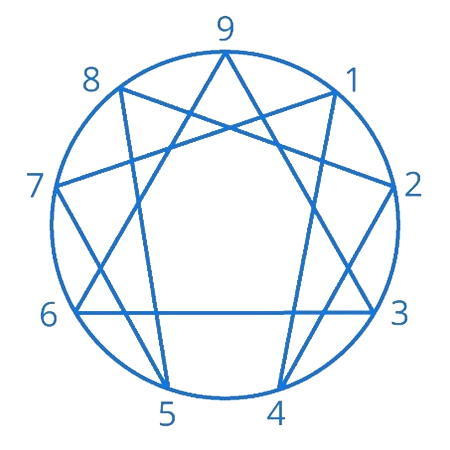Renowned enneagram expert and author, Russ Hudson spoke with spiritual teacher and founder of the Diamond Approach to Realization A. H. Almaas to explore the Transformational Power of the Enneagram.
To work effectively with the enneagram it’s important to understand the difference between spiritual transcendence (‘states of being’ that are beyond one’s normal experience, beyond the self, beyond the individual, beyond the human being) and spiritual transformation (a change of something into something else – who/what we are transforms from the life of the ego to the essential). In general, spiritual teachings and paths tend to emphasize either spiritual transcendence or spiritual transformation.
The enneagram is more oriented toward transformation as it is quite useful and powerful as a tool in the clarification of the personality, the work needed to loosen the grip of the past, our personality type, on us.
“I have often been quoted from a teaching I offered many years ago: ‘The Enneagram does not put you in a box. It shows you the box you are already in without realizing it, and the way out.’ At its core, the Enneagram was never meant to be merely a way of categorizing people. It was primarily a way of customizing what will be most effective and helpful in the journey of seeing through our fundamental egoic patterns, and ultimately, integrating them into the larger sense of our Being–what A.H. Almaas calls ‘our True Nature.‘ It also trains us in more accurate self-observation which is vital to the path of realization and actualization. It helps us see more precisely the relationship between the core issues of our ego and the sense of what we are beyond that. Thus, it is both an opening to the deeper mysteries of being a human being and a great help in avoiding the allure of ‘spiritual bypass.'” – Russ Hudson

When we talk about personality types, we are addressing the experience and development of our psyche (from the Greek psykhe, which means “the soul, mind, spirit, or invisible animating entity which occupies the physical body) and how we came to be the way we are and how the resulting patterning and familiarity have a tendency toward the perpetual motion of self-definition.
Interest in our personality type is often the beginning of interest into the nature of life, reality, and the human being – the depth of us.
The enneagram has opened the door for tens of thousands of individuals to begin their exploration of their psyche, their consciousness.
The enneagram is used in the Diamond Approach in several ways:
- For insight into our personality and character structure which illuminates doorways for inquiry. Inquiry is used to “peel the onion,” moving beyond the constructed to what’s real in us.
- As a map of how our type responds and reacts to emotional and situational events. This and having insight into how our attention works in habitual ways to support a specific worldview coupled with how the Diamond Approach employs working with object relations, brings incredible potency and precision to our inquiry.
- We work with specific enneagrams to investigate the nature of reality and what blocks or distorts our ability to perceive true nature as it is. These enneagrams include the Enneagram of Holy Ideas, the Enneagram of Passions and Virtues, and the Enneagram of Ego Ideals. Working with these enneagrams bring in subsets of enneagrams within each body of work.
Attending to our experience to understand it, to clarify the consciousness that is having the experience, so that we begin to recognize consciousness as a medium that can be clear, and subtle, and tranquil. That tranquility can then become a window that opens us up to the transcendent. We can find that this consciousness can lose its defining boundaries and be expanded to become vast, endless, unbounded. – A. H. Almaas (Hameed Ali)
Russ and Hameed explore some of the stages of working with the enneagram as well as sharing personal experience and understanding of the transformational power of the enneagram.

Stages of Working with the Enneagram
- Stage 1 – Working with Your Personality Type
- Becoming aware of the Enneagram and learning the basics
- Identifying your type and exploring the traits and characteristics of your type
- Understanding how to use the enneagram as a map of how the personality functions
- Working with the influences of your type’s wings
- Recognizing your instinctual subtype
- Stage 2 – Recognizing and Working with Essence
- What is beyond personality?
- Becoming aware that you are deeper and more real than personality
- Stage 3 – Keys to the Enneagram
- Articulates how the “shell” (the ennea-type) reflects a fundamental truth.
- Each type is constellated around a spiritual truth
- How traits and patterns express an aspirational ideal
- Leads to recognizing one’s spiritual endowment
- Stage 4 – The Holy Ideas
- Connects Types to Universal Spiritual Principles
- Reveal a Map of Reality as Unity
- A Perspective of the Objective View of Reality
- Stage 5 – Passions and Virtues
- Passions
- Emotional/Affective Atmosphere (compulsive, reactive, charged, etc.)
- Virtues
- Affective states resulting from integration of Holy Ideas
- Passions
The Diamond Approach makes it clear that personal work with the enneagram is not restricted to one’s specific point of fixation and that freeing the soul and reconnecting to essence and true nature requires each of us to work with and through all nine points.
One way of understanding this (using point 8):

Eight is directly connected to points 2 and 5. Eight is influenced by its wings 9 and 7. Eight’s heart point two is influenced by its wings 1 and 3. Eight’s stress point five is influenced by its wings of 4 and 6. Thus, all nine points influence point eight all the time.
Join Russ and Hameed for an intriguing and stimulating discussion on the transformative power of the enneagram.

Russ Hudson has established himself as one of the top teachers and developers of the Enneagram personality typology in the world today. He has been writing and teaching full-time with The Enneagram Institute as well as on his own since 1991 and has co-authored with Don Richard Riso five best-selling books on the subject, including The Wisdom of the Enneagram and Personality Types. These books are widely considered to be not only groundbreaking contributions in the field of Enneagram studies, but also important contributions to the literature of psychological type and have been translated into French, German, Italian, Spanish, Japanese, Russian, Korean, Thai, Chinese, Dutch, Polish, Hungarian, Portuguese, Greek, and Czech editions, with more on the way. They are the best-selling Enneagram books in their respective countries.

A. H. Almaas is the pen name of A. Hameed Ali, founder of the Diamond Approach to Self-Realization, a contemporary teaching that developed within the context of both ancient spiritual teachings and modern depth psychology theories. Almaas has authored eighteen books about spiritual realization, including the Diamond Heart series, The Void, The Alchemy of Freedom, Facets of Unity, and Keys to the Enneagram. He is the founder of the Ridhwan School for Spiritual Development, an inner work school devoted to the realization of True Nature. The orientation of the school is directed toward guiding students to realize their true nature to the fullest realization and further still to endless enlightenment.
